Andrew Wood – with images by John Gould and Steve Jones
When amateur astronomers set up their telescopes, what are the objects they aim to observe?
The aim of this post is to give basic information about those objects beyond our solar system. These stars, star clusters, nebulae and galaxies are given the collective name of Deep Sky Objects.
Within our solar system, everything we see; Moon, planets, comets and asteroids, we see only because of light generated by the Sun reflected back to Earth. We observe objects in the solar system as they were a matter seconds, for the Moon, or minutes or hours ago for planets and other objects. This reflects how far away they are and how long their reflected light takes to reach us at the speed of light.
Once beyond the solar system, the nearest stars are light years away. So, we move from hours, beyond days, weeks and months, to years of light travel once we are out of our solar system. Most of the stars we see with the naked eye are hundreds or thousands of light years away; and some objects for which we need a telescope are millions of light years away. Hence the term Deep Sky.
Naming Deep Sky Objects
Some well-known objects are named e.g. Great Nebula, Butterfly Cluster.
All objects are named in one or more catalogues. The most common catalogues are:
Messier: This catalogue contains 110 objects which are given the designation M.
New General Catalogue: contains more than 7,000 objects with the designation NGC.
Index Catalogue: contains more than 5,000 objects with the designation IC.
Bayer designation: the brightest star in a constellation is identified by the Greek letter alpha (α), the next brightest beta (β) and so on to omega (ω). Beyond that, other designations take over. (Some stars also have common names, such as Antares, the brightest star in Scorpius; which is also designated α-Scorpii).
There are other catalogues, though those above are the major ones used by amateur astronomers.
Magnitude
The Magnitude of a deep sky object is simply a number that reflects how bright it is. The larger the number, the fainter it is. In a dark sky, around magnitude 6 is the limit of what can be seen with the naked eye. Most deep sky objects are beyond naked eye brightness and require a telescope.
Deep Sky 101.1 – Double Stars
A high proportion of stars do not exist in isolation, existing in a Double Star system (another term often used is Binary Star). Stars form from rotating disks of gas and dust under gravity. Double stars form when the disk fragments, with a second star forming within the disk, surrounded by its own disk. The two stars form an orbiting pair.
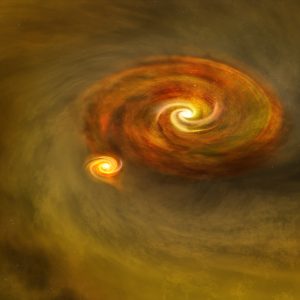

The result is that a planet in a solar system with a double star at its centre will have two “suns” around which it orbits.
The images above are artistic interpretations. When viewing double stars from Earth through a telescope, each pair has its own unique set of properties, as illustrated below.
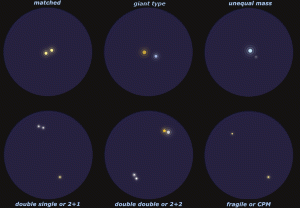
Seeing two stars close together through a telescope can also accentuate any colour difference between the stars– as seen in the figure above.
Whether or not your telescope will “split” a double star depends on:
- The angular separation of the two stars in arcseconds [1 degree = 60 arcminutes. 1 arcminute = 60 arcseconds. A an arcsecond is 1/3600th of a degree]. We normally say a double star system is separated by ‘x’ seconds (“).
- The brightness difference between the stars. Sometimes even in a widely separated pair the luminance of the brighter star (usually referred to as the A component) makes it difficult to see its fainter companion (the B component).
- Atmospheric conditions – higher magnification can help in good “seeing”, when the atmosphere is steady.
- The aperture – diameter of the mirror or lens that collects the light. Larger aperture telescopes have better theoretical resolution – ability to split two points of light. Smaller high-quality refractors, however, often have better resolution than larger reflectors, which are better at seeing fainter deep sky objects. Ignore any formulae for theoretical limit and test out your own telescope.
Most star atlases list tables of double stars that you can observe and test out your telescope and observing prowess. Many double stars can be observed in less-than-optimal conditions, under suburban skies with light pollution or with a bright moon present.
A few well-known examples visible from the southern sky are:
- Alpha Centauri – the brighter of the two ‘pointers’ that aim at the Southern Cross has components of magnitude 0.0 and 1.2. One of the brightest naked-eye stars, the A and B stars are currently separated by about 5” and easily separated by most telescopes. This gap will widen until 2030 then start to narrow until 2035, then widen again to its greatest separation around 2060.
- Acrux – the brightest star in the Southern Cross is actually a Triple Star. The closer components are of magnitudes 1.3 and 1.7 separated by 4”. There is a third component at a much wider separation to the close pair.
- Antares – or alpha Scorpii – is a challenge. Separated by 2.5”, the A component at magnitude 1.0 completely overwhelms the B component at magnitude 5.4, making it very difficult to see. If you do happen to have the telescope and conditions that do split the pair, the fainter component is a distinct green colour, next to the red of the brighter supergiant.
- Sirius – or alpha Canis Majoris is another challenge. The brightest star in our night sky, at magnitude -1.5, has a white dwarf companion of magnitude 8.5. This large brightness difference makes the fainter star very difficult to see, despite a wide separation. Currently about 9”, this separation would normally be an easy split in any telescope.
- Rigel – or beta Orionis, is another pair with a large magnitude difference (0.1 and 6.8) with a separation of 10”. In this case, though, it is generally easy to split.
Deep Sky 101.2 –Star Clusters
As illustrated by Double Stars, most stars do not exist in isolation. In fact, there are a multitude of clusters of stars containing tens, hundreds, and thousands of stars. Star Clusters fall into two groups: Open Clusters and Globular Clusters.
101.2.1 – Open Clusters
Open star clusters are groups of stars that are loosely bound together by gravitational forces and were formed from the same giant molecular cloud. Typically containing a few hundred to a few thousand stars, these clusters are found within the galactic plane of galaxies, including our Milky Way. They are relatively young, often just a few million years old, and can provide valuable insights into the processes of star formation and the evolution of galaxies. Unlike their more tightly bound counterparts, globular clusters, open star clusters tend to disperse over time due to interactions with other stars and molecular clouds. [via Copilot]
Observing Open Clusters
- Some are bright enough and large enough to see with the naked eye e.g. Pleiades (Seven Sisters)
- Some can easily be seen with binoculars, making it easy to then aim a telescope
- Generally bright enough for small telescopes – great visual objects for those starting out in Astronomy
- Great backyard objects. In fact, when out under dark skies, Open Clusters can be difficult to pick out from the background stars in the rich star-fields of the Milky Way, and most are bright enough to be seen in fairly light-polluted areas.
- Also great for starting out in Astrophotography. They generally do not require long exposures.
Below are images of bright southern sky Open Star Clusters taken by Shoalhaven Astronomers members.
Jewel Box – Image by John Gould
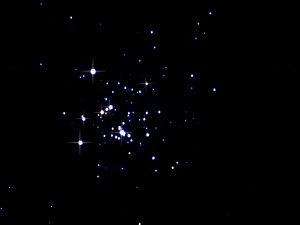
The “Jewel Box”, (NGC 4755), above, can be seen with the naked eye, or easily picked up using binoculars, as a small knot of stars near the second brightest star in the Southern Cross, Mimosa (beta-Crucis). It makes a wonderful telescopic object, with different coloured stars. NGC 4677 has a magnitude of 4.2, is 10 arcminutes in size and 7,600 Light Years from Earth.
Pearl Cluster – Image by John Gould
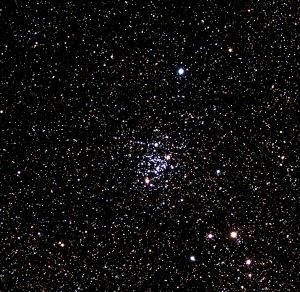
The small but bright Pearl Cluster (NGC 3766) stands out among the rich star fields of the constellation Centaurus. With a magnitude of 5.3 and 12 arcminutes across, it is easily seen in a small telescope. NGC 3766 is 5,500 Light Years from Earth.
101.2.2 – Globular Clusters
Globular Star Clusters are spherical collections of stars that orbit the core of a galaxy. These clusters are densely packed, containing thousands to millions of stars, which are bound together by gravity. They are typically composed of older, metal-poor stars and are found in the halo of galaxies, including our own Milky Way. Globular clusters are important for astronomers as they provide insights into the early stages of galactic formation and evolution, and their study can help unravel the history and dynamics of galaxies. [via Copilot]
As the description above describes, Globular Clusters are densely packed, spherical groups of stars. John Gould’s images below of the largest of the Milky Way globular clusters, Omega Centauri, illustrates this.
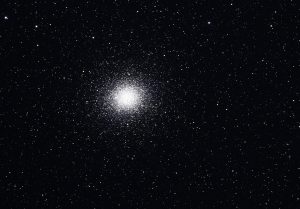
Omega Centauri (NGC 5139) lies 16,500 Light Years from Earth out of the main plane of the Milky Way galaxy, where all of the globular clusters are located. With a magnitude of 3.7 and 36 arcminutes in diameter, the non-stellar nature of the cluster can be seen with the naked eye under a dark sky and is easily seen in binoculars. Increasing size of telescope and high magnification resolves the cluster in a multitude of star.
There are about 150 globular clusters of various brightness and size located in the “galactic halo” above and below the plane of the spiral Milky Way.
101.3 – Nebulae
Nebulae are vast clouds of gas and dust in space, often serving as the birthplace of stars. They can be observed in various shapes and sizes, some glowing brightly with emitted or reflected light, while others remain dark, obscuring the light from objects behind them. Nebulae are primarily composed of hydrogen, with helium, oxygen, and other elements mixed in. The intricate patterns and colours seen in nebulae are created by the interactions of their constituents with radiation from nearby stars. These celestial formations are critical in the lifecycle of stars and play a significant role in the ongoing process of cosmic evolution. [via Copilot]
There are many different types of nebulae, some of which are well-illustrated in the image below by John Gould.
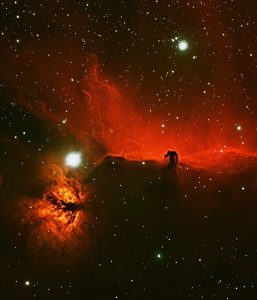
John’s image shows the famous Horsehead Nebula (Barnard 33), its shape quite obvious. This is an example of a Dark Nebula.
Behind the Horsehead is the bright Emission Nebula IC 434. Another example of an Emission Nebula, the Flame Nebula (NGC 2024), can be seen in the lower left of the image.
Note that the colours seen in the images do not show up when viewing nebulae through a telescope. Large aperture telescopes may show some colour, though the telescopic view is generally black-and-white. Nebula Filters, which screw into eyepieces, are also very useful when viewing, rather than imaging, nebulae.
101.3.1 – Dark Nebulae
A dark nebula, also known as an absorption nebula, is a type of interstellar cloud that is so dense it obscures the light from objects behind it. Unlike emission or reflection nebulas, which are visible due to the light they emit or reflect, dark nebulas are visible because they block the light from stars and other luminous objects. These regions are composed primarily of gas and dust, and they often appear as dark patches or silhouettes against the brighter background of stars or glowing nebulae. Dark nebulas are significant in the study of star formation, as they can be the birthplaces of new stars. [via Copilot]
As already mentioned, the Horsehead Nebula in the image above is a famous example of a Dark Nebula. Any region of sky otherwise punctuated by stars with a patch devoid of stars is likely to be, not an area with no stars, but a dark nebula obscuring the stars behind it.
Another famous example is the Coal Sack near the Southern Cross, as shown in the image below. The dark area just below the Southern Cross in the upper part of the image is a large Dark Nebula obscuring the light from background stars.

101.3.2 – Emission Nebulae
An emission nebula is a type of interstellar cloud that glows brightly due to the ionization of its gases by high-energy photons from nearby hot stars. These nebulae are often regions of active star formation and are characterized by their vivid colours, typically red or pink, due to the presence of hydrogen gas. The ultraviolet radiation from young, massive stars excites the hydrogen atoms, causing them to emit light as they return to their ground state. Emission nebulae are essential in the study of the lifecycle of stars and the dynamics of interstellar matter. [via Copilot]
Two examples of Emission Nebula, IC 343 and NGC 2024 can be seen in the previous image. More examples are below.
Rosette Nebula (NGC 2244) – image by John Gould
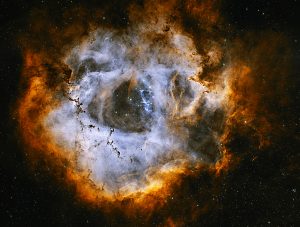
Running Chicken Nebula (IC 2944) – Image by John Gould
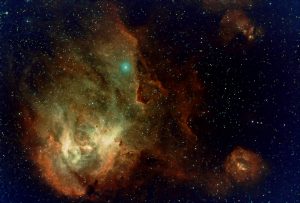
101.3.2- Planetary Nebulae
A planetary nebula is a type of emission nebula consisting of an expanding shell of ionized gas that is ejected from red giant stars late in their lives. The name “planetary nebula” originates from their appearance, which can resemble a planet when viewed through a small telescope, though they are unrelated to planets. These nebulae are formed when a star of intermediate mass, such as our Sun, reaches the end of its life cycle and expels its outer layers into space. The remaining core of the star becomes a white dwarf, and the expelled material glows due to the ultraviolet radiation emitted by the hot white dwarf. [via Copilot]
One of the most famous planetary nebulae is the Helix Nebula. The image below was created by Steve Jones.
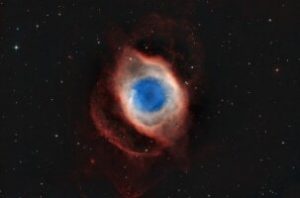
The Helix Nebula (NGC 7293) is a large planetary nebula located in the constellation Aquarius. It has a magnitude of 7.6, is 25 arcminutes across and lies 695 Light Years from Earth.
101.3.4- Reflection Nebulae
A reflection nebula is a type of interstellar cloud that shines not by emitting its own light, but by reflecting the light of nearby stars. These nebulae are composed of fine dust particles that scatter the light from stars, typically resulting in a blue hue due to the scattering of shorter wavelengths of light. Unlike emission nebulae, the gases in reflection nebulae are not ionized, and they do not glow independently. Reflection nebulae are often found in regions of star formation and can provide valuable information about the properties of the surrounding stars and the interstellar medium. One of the most famous reflection nebulae is located around stars of the Pleiades open cluster, also known as the Seven Sisters, which is located in the constellation Taurus. [via Copilot, with modification]
John Gould’s image of the Pleiades is shown below. The major stars of this cluster are easily seen with the naked eye. The long exposure of the image brings out the nebula left over from the formation of these young stars. The nebula is seen due to the light from the stars.
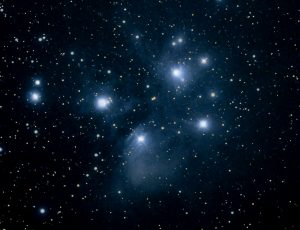
That the nebula shines with a bluish colour in the Pleiades is typical of reflection nebulae as blue light is scattered more efficiently by dust particles than red light. Another example can be seen in the image of IC 4592 below.
IC 4592 – image by Steve Jones
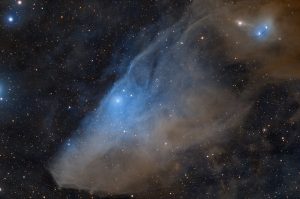
IC $592 is also known as the Blue Horsehead Nebula. It lies not far from a region of complex nebulae near the star Rho Ophiuchi.
Rho Ophiuchi Complex – image by Steve Jones
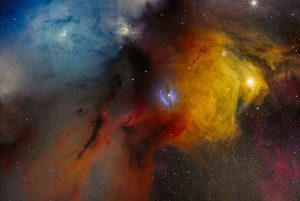
This complex is a combination of Dark, Emission and Reflection nebulae, all related to star formation:
Dark Nebulae – where a vast dust cloud is condensing under gravity. No stars have yet formed to produce light.
Emission Nebulae – where young stars excite hydrogen gas to produce the reddish colours.
Reflection Nebulae – where light from fully formed stars lights up any leftover surrounding gas, glowing blue.
Where does all the gas for star formation come from? From the death of stars in supernova explosions.
101.3.5- Supernova Remnants
A Supernova Remnant is the structure resulting from the explosion of a star in a supernova. This catastrophic event marks the end of a star’s life cycle, particularly for massive stars. The explosion ejects the star’s outer layers into space, leaving behind a dense core, which might form a neutron star or black hole, depending on the original star’s mass. Supernova remnants are composed of the expelled material and the shock waves generated by the explosion. The remnants typically appear as expanding clouds of gas and dust, often with complex structures formed by the interaction of the shock waves with the surrounding material. [via Copilot]
In the southern hemisphere sky lies the Vela Supernova Remnant, the aftermath of a supernova explosion that occurred 11,000 years ago.
Vela Supernova Remnant – image by Steve Jones
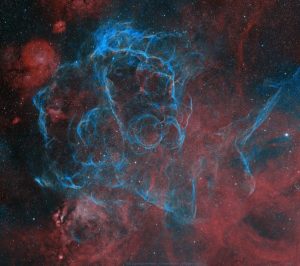
Supernova Remnants are difficult to observe through a telescope. They are usually large and tenuous. A very dark sky, large aperture and low magnification – to produce a wide field – and probably a nebula filter are required to glimpse the tenuous gas and dust, without the colour produced through imaging.
Within that tenuous gas and dust lie all of the elements that may one day result in new stars and the planets that orbit them.
101.4 Galaxies
All of the Deep Sky Objects described above occur within our home Milky Way Galaxy, containing hundreds of billions of stars. Being 100,000 light years across and 20,000 light years wide, the objects observed within our galaxy are thousands of light years away from Earth.
Ours is only one of billions of galaxies. Galaxies beyond our own are the most distant of the Deep Sky Objects, being millions of light years away. All will have their own DSOs and for some of the larger and closer galaxies, some of these objects can be seen through amateur telescopes.
For the most part, however, they appear ‘fuzzy’. It takes large aperture telescopes and high magnification to see any detail. The thrill is in knowing you are observing something as it was a very long time ago.
There are different types of galaxies, and the general outline of these can often be seen through a telescope.
101.4.1 Spiral Galaxies
A spiral galaxy is a type of galaxy characterized by its spiral structure, which is composed of stars, gas, and dust. These galaxies are among the most beautiful and recognizable objects in the universe, with their majestic arms winding outward from a central bulge. The Milky Way, our own galaxy, is a classic example of a spiral galaxy. [via copilot]
When viewed through a telescope, the appearance of spiral galaxies can differ depending on how the galaxy is oriented from our position on Earth. The two galaxies in the images belwo illustrate this.
NGC 253- image by Steve Jones
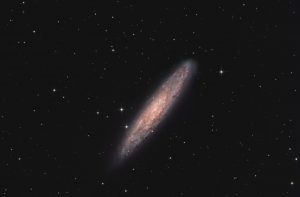
Also known as the Silver Coin Galaxy, NGC 253 is tilted from our viewpoint on Erath, allowing us to see its elongated shape as well as its spiral structure. It is located in the constellation of Sculptor. Its magnitude is 7.1, it dimensions are 25.1 x 7.4 arcminutes, and it is11 Million Light years from Earth.
NGC 1566 – image by Steve Jones
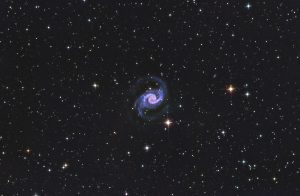
NGC 1566 is oriented ‘face-on’ toward Earth revealing its spiral structure. Located in the constellation Dorado, it has a magnitude of 9.4, a diameter of 7 arcminutes and is located 51 Million Light Years from Earth.
101.4.2 Barred-spiral Galaxies
A barred spiral galaxy is a type of spiral galaxy that features a central bar-shaped structure composed of stars. This bar extends from the nucleus of the galaxy and is connected to its spiral arms. The presence of the bar can influence the motion of stars, gas, and dust within the galaxy and is thought to play a role in the galaxy’s evolution. [via Copilot]
A classic barred-spiral galaxy is shown in the image below.
M83 – image by John Gould
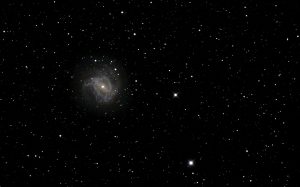
M83 (NGC 5236) has a magnitude of 7.5. This bright magnitude and its size of 13 arcminutes makes it an easy telescopic object. The galaxy is 15 Million Light Yeras from Earth.
Although their barred nature is difficult to see due to their orientation, NGC 55 and NGC 4945 in the images below have been determined by astronomers to be barred-spiral galaxies. This illustrates how, across the vastness of universe, the appearance of galaxies is influenced by their orientation in space as we see them from Erath.
NGC 55 – image by Steve Jones
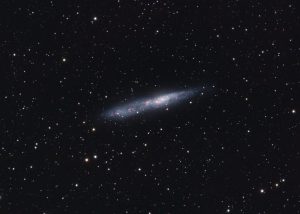
NGC 55 is located in the constellation Sculptor, has a magnitude of 8.1, dimensions 30 x 6 arcseconds, and lies 4 Million Light Years from Earth.
NGC 4945 – image by John Gould

NGC 4945 (sometimes called the Tweezers Galaxy) in the constellation Centaurus has a magnitude of 8.4, its size is 20 x 4 arcminutes, and it is 12 Million Light Years from Earth.
101.4.3 Elliptical Galaxies
An elliptical galaxy is a type of galaxy characterized by its ellipsoidal shape and smooth, nearly featureless brightness profile. Unlike spiral galaxies, elliptical galaxies lack significant structure such as spiral arms and contain older, less massive stars with minimal amounts of gas and dust. They are often found in galaxy clusters and can vary greatly in size. [via Copilot]
The image below of a cluster of galaxies in the constellation Virgo – galaxies do often occur in clusters – shows a string of galaxies with the elliptical galaxy M87 marked at lower left. The other galaxies in the image are a mixture of elliptical and spiral galaxies.
Galaxy cluster in Virgo – image by John Gould

The galaxy at lower left in the image above is M87 (NGC 4486). It has a magnitude of 8.6, size of 8 arcminutes and lies 53 Million Light Years from Earth.
Elliptical galaxies are typically much larger than spirals. M 87 is a giant galaxy containing trillions of stars and about 15,000 globular clusters. A typical spiral galaxy such as the Milky Way contains hundreds of billions of stars and less than 200 globular clusters.
101.4 Irregular Galaxies
An irregular galaxy is a type of galaxy that lacks a distinct shape or structure, unlike spiral or elliptical galaxies. These galaxies often appear chaotic, with no defined nucleus or spiral arms, and contain a mix of young and old stars, along with varying amounts of gas and dust. Irregular galaxies are typically smaller and less massive than other types of galaxies and can be found in various environments throughout the universe. [via Copilot]
Double Stars, Star Clusters, Nebulae and Galaxies are all out there in the Deep Sky awaiting to be observed and imaged from our home planet.